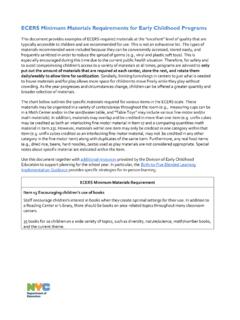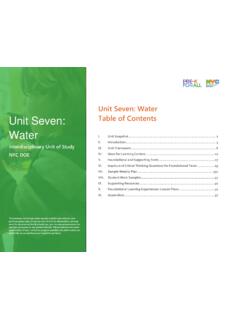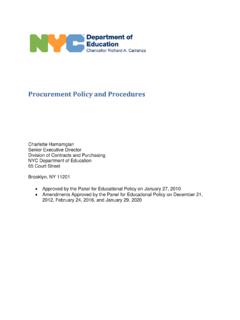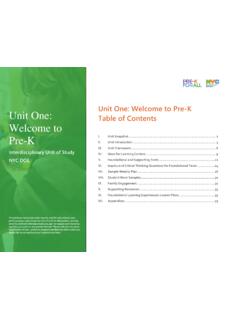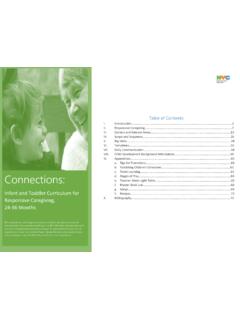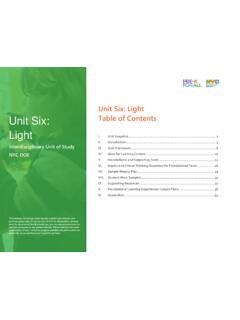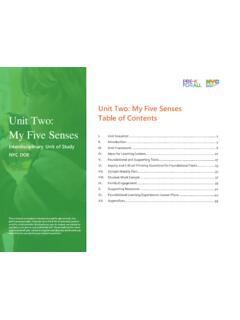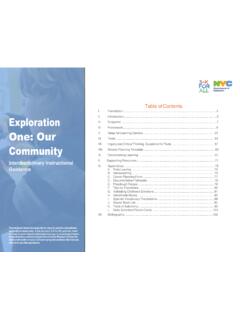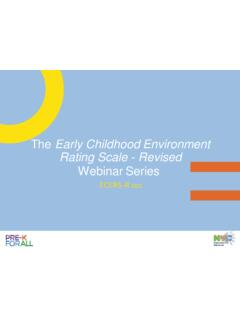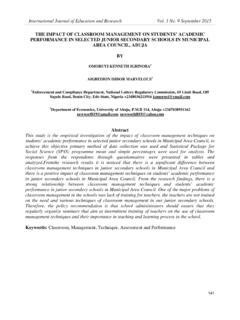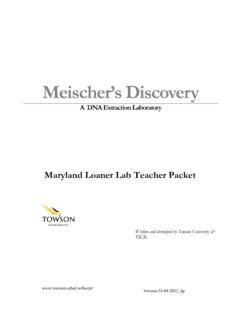Transcription of Using IEP Goals in the Pre-K Classroom
1 Using IEP Goals in the Pre-K Classroom If a child is found eligible to receive preschool special education services, an Individualized Education Program (IEP) is developed. An IEP is about an individual child and how to meet his or her unique needs within the context of an educational environment. An IEP documents a child s current skills and abilities, determines what special education supports and services will be provided, and establishes educational and developmental Goals . The IEP is a tool that ensures that a child with a disability has access to the general education curriculum and is provided the appropriate services and supports needed to progress toward achieving the preschool learning standards while meeting his or her unique needs related to the disability.
2 IEP Goals IEP Goals consist of measurable annual Goals and short-term instructional objectives. Measurable annual Goals describe what a child with a disability can reasonably be expected to accomplish within the school year in which the IEP is in effect. There should be a direct relationship between the measurable annual Goals on the IEP and the child s present levels of performance (PLOPs). Annual Goals can be academic, address social or behavioral needs, relate to physical needs, or address other needs unique to the child. These Goals should be measurable, meaning they can be monitored to determine whether the child has achieved the Goals . For each annual goal, the IEP must indicate criteria (measure used to determine if the goal has been achieved), method (how progress will be measured), and schedule (when progress will be measured).
3 Short-term instructional objectives are used to determine, at intermediate times during the school year, how well the child is progressing toward achievement of the annual goal. These objectives provide the basis to determine how a child is progressing toward his or her annual goal. Below is content from a sample IEP for a student named Tristan: Measurable Annual Goals : The following Goals are recommended to enable the student to be involved in and progress in the general education curriculum, address other educational needs that result from the student's disability, and prepare the student to meet his/her postsecondary Goals . Annual Goal (what the student will be expected to achieve by the end of the year in which the IEP is in effect): By June 2021, Tristan will improve his interactions with peers in social situations.
4 Criteria (measure to determine if goal has been achieved): 80% accuracy (4 out of 5 opportunities). Method (how progress will be measured): Teacher observations (student dictation, photographs, anecdotal notes). Schedule (when progress will be measured): Quarterly. Short-term instructional objectives and/or benchmarks (intermediate steps between the student's present level of performance and the measurable annual goal): Tristan will establish and maintain close proximity with his peers for at least five minutes on 4 out of 5 consecutive opportunities. With prompting and support, Tristan will initiate a play activity with peers during child-centered free choice activities for 4 out of 5 opportunities for 3 consecutive days.
5 With faded prompts, Tristan will cooperatively play with peers during child-centered free choice activities for at least ten minutes on 4 out of 5 consecutive opportunities. With faded prompts, Tristan will be able to maintain a conversation with at least 4 verbal exchanges in 4 out of 5 opportunities. Lesson Planning in the preschool Classroom All programs should promote a culture of high expectations for all students. For children with IEPs, lesson planning can support progress towards IEP Goals in a natural setting and provide the necessary supports to ensure access to general education curriculum and peers. In a daily lesson plan, teachers can incorporate IEP Goals and identify specific strategies to support progress towards Goals .
6 Identified strategies should be shared with all adults involved in the implementation of the child s IEP, including teacher s assistants/paraprofessionals, related service providers, and special education itinerant teachers (SEIT). Classroom staff should be informed of their individual responsibilities in implementing strategies within the daily activities throughout the school day. Below is a sample content for a student named Tristan that can be used to support the integration of IEP annual Goals and short-term objectives within daily activities: Activity: Center/Choice Time. Annual Goal: Improve interactions with peers in social situations. Short-Term Objective: Establish and maintain close proximity with peers for at least five minutes Strategies: Provide prompting to facilitate Tristan joining a center with other peers.
7 Model how to approach other children already engaged in play at centers, , hi to peer when entering activity. Provide verbal instruction or gesture to signal to move closer to peer Assessment: Photographs, observation notes, student dictation, checklist, work samples. Lesson planning should consider the individual needs of the child in relation to his or her disability in order to ensure access to the general education curriculum and standards. Some questions to think about when determining strategies to support the needs of students with disabilities: What are the child s needs in relation to the disability? When and how does the child struggle to access the general education curriculum?
8 Where might this child potentially face challenges within the identified activity? What strategies could support the child is reaching short-term objectives and working towards annual Goals ? The purpose of the lists below is to provide possible strategies to implement and consider during lesson planning to meet the individual needs of a student with a disability. These lists below are not exhaustive and are meant to be used as a guide during planning. Approaches to Learning, Foundational Skills (Engagement, Creativity and Imagination, Curiosity and Initiative, Persistence): Minimize transitions Use visual supports and cues Use proximity seating Provide a variety of materials that match children s interests and skill levels Provide a peer model Be flexible regarding time for activities (provide additional time as needed) Be aware of children s sensory preferences Post schedules and/or student charts at eye level Provide repeated opportunities to practice skills Provide clear directions and expectations (repeat as needed)
9 Simplify task directions Sequence learning tasks from simple to complex Eliminate clutter Reduce distractions, including background noise, as much as possible Physical Development and Health (Physical Development, Physical Fitness, Health and Well Being, Health and Safety): Provide developmentally appropriate materials and equipment (magnifiers, wide crayons and markers, rubber writing grips, adjustable writing platforms, large print) Provide cues as needed to help children improve coordination and control of muscles Model movements and have children imitate Model how to hold writing tools, scissors, etc. Social and Emotional Development (Self Concept and Self Awareness, Self-Regulation, Relationships with Others, Accountability, Adaptability).
10 Review class expectations and rules frequently Provide extra structure and support during transitions (visual and verbal cues, individual schedule, songs) Provide a peer to help model appropriate behaviors Follow a specific and consistent routine Alternate quiet and active tasks Allow for breaks as need (cozy/quiet area) Model coping strategies to label and deal with feelings Consider arrangement of environment and placement of materials for easy access to children Limit distractions (visuals, noise levels, lighting) Model cooperative play Provide positive verbal (tone, calm voice) and non-verbal (getting down to child s level, smiling, making eye contact) interactions with children Provide for calming activities, such as sensory materials or soothing music Communication, Language and Literacy (Approaches to Communication, English Language Arts and Literacy).
